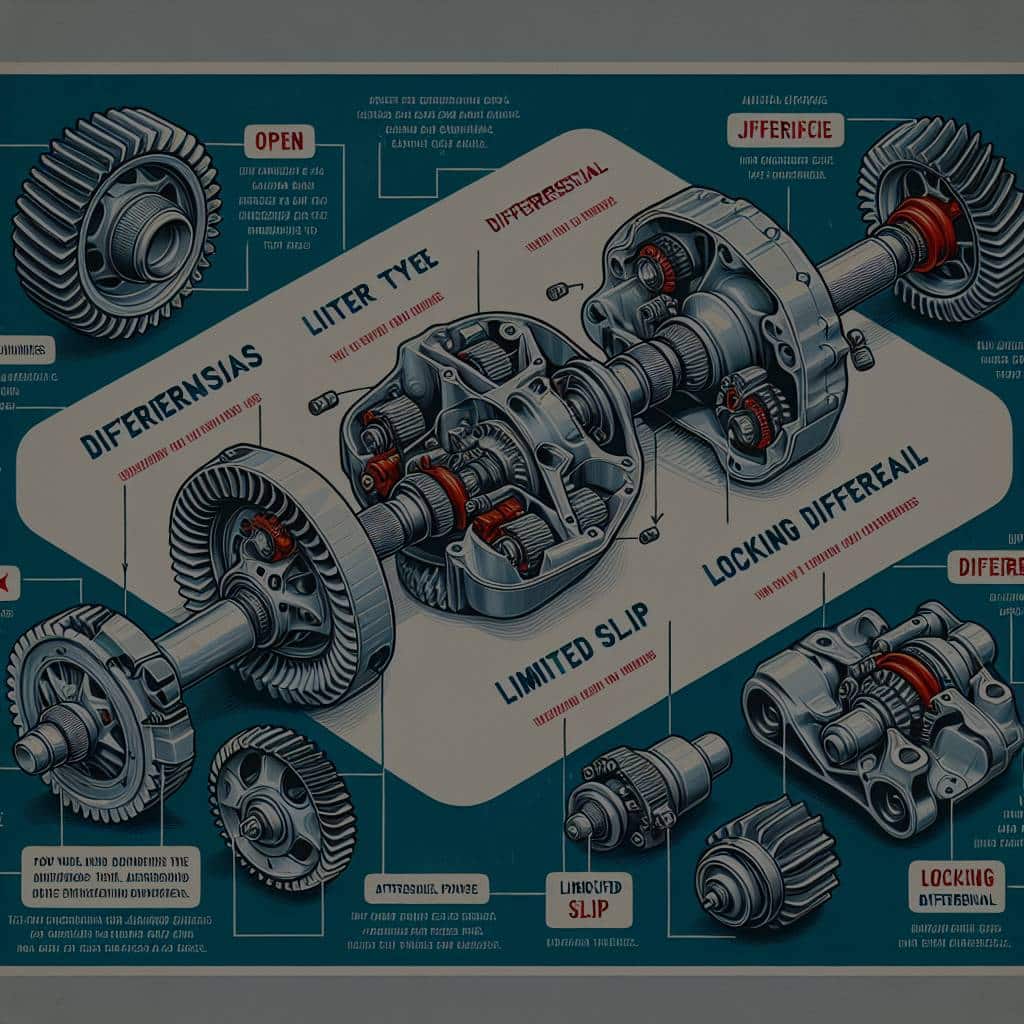What’s the Best Type of Differential for Traction in a Rear-Wheel-Drive Sports Car?

The quest for optimal traction and handling in sports cars is a tale as old as the automobile itself. Power, grip, and control are the key ingredients for a thrilling drive, and the differential is one of the most critical components to achieving this sweet spot. Differential, the device that splits the engine torque two ways, allowing the wheels to spin at different speeds, is where this magic happens. Today, we dive into the wide range of differentials used in rear-wheel-drive (RWD) sports cars. Our focus will be on which is the best for enhancing traction, considering various driving conditions such as road, snow, and even a bit of off-road venture.
Understanding the Role of the Differential
Before we delve deep into the kinds of differentials, it’s vital to understand the role this component plays in your vehicle. The differential is at the heart of the vehicle’s drivetrain, nestled between the two wheels of an axle. Its job is to allow these wheels to spin at different speeds, something necessary when taking a turn, as the outer wheel will have a greater distance to cover than the inner wheel.
Topic to read : How to Use a G-Force Meter to Optimize the Performance of Your Sports Car on the Track?
In a RWD vehicle, the engine’s power is sent to the rear differential, where it’s then distributed to the rear wheels. This configuration has long been favored in sports and performance cars for its benefits in handling, weight distribution, and the ‘driving feel’ that car enthusiasts crave.
The differential’s role in managing traction is crucial. When a vehicle accelerates, particularly a powerful sports car, the tires need to maintain grip on the road surface. If a tire loses traction, it will spin, wasting power and potentially causing the car to lose control. This is where the differential steps in, controlling the amount of power sent to each wheel to prevent slippage.
Topic to read : Unforgettable desert safari dubai experiences at great prices
Types of Differentials and Their Benefits
There are several types of differentials used in RWD vehicles, each with its unique characteristics and benefits.
Open Differential
First up is the open differential, the most basic and common type. It works on a simple principle, allowing each wheel to rotate independently. As such, it guarantees that each wheel will receive equal torque. However, this can be a disadvantage on slippery surfaces like snow or mud. If one wheel starts to slip, the differential will continue sending it power, effectively reducing the power to the wheel with grip.
Limited Slip Differential (LSD)
Limited Slip Differentials, or LSDs, are a big step up from open differentials. An LSD still sends power to both wheels but includes a mechanism that limits the speed difference between them. When one wheel starts to lose traction, the LSD will reduce the power to that wheel and increase it to the other one. It offers the perfect balance of power distribution and improved traction, which is why LSD is a common feature in performance-oriented RWD cars.
Electronic Limited Slip Differential (eLSD)
The Electronic Limited Slip Differential (eLSD) is a modern, sophisticated variant of the LSD that uses computer-controlled electronics to manage the power distribution between the wheels. It can react faster than a mechanical LSD and is more adaptable to various conditions.
The Best Differential for Traction
So, which of these differentials offers the best traction for a RWD sports car? The answer depends on the specific driving conditions and performance goals.
For general driving and moderate performance use, the LSD is an excellent choice. It provides improved traction over an open differential and is a staple in many sports cars. Its mechanical operation gives it a predictable, consistent feel that many drivers appreciate.
However, for those wanting the absolute best in traction and performance, particularly in challenging conditions like snow or poor-quality roads, the eLSD is the way to go. Its ability to adapt to changing conditions on the fly and instantly adjust power distribution is unparalleled. It can provide traction where an LSD or open differential would falter.
Choosing the Right Differential for You
While it’s essential to consider the differential’s role and types for optimal traction, it’s equally crucial to understand your driving needs and preferences. If you’re a committed driving enthusiast who loves the thrill of high-performance driving, an LSD or eLSD is the clear choice.
However, if you’re more of a casual driver who’s concerned about handling in a variety of conditions, the eLSD’s adaptable nature might be the best fit. It offers the best of both worlds, with advanced technology for optimal traction and the ability to handle a wide range of driving conditions.
Remember, the differential is only one piece of the traction puzzle. Tires, suspension, and vehicle weight distribution all play significant roles in overall traction and handling.
Choosing the best differential for your RWD sports car will significantly enhance your driving experience. But remember, no matter how sophisticated your differential may be, it can only do so much. Regular maintenance, careful driving, and understanding your car’s limits will ensure that you get the most out of your vehicle and drive safely at all times.
The Role of Differential in Various Drive Systems
Now, let’s talk about how differentials play into various drive systems, such as front-wheel drive (FWD), rear-wheel drive (RWD), and all-wheel drive (AWD). In FWD vehicles, the power from the engine is sent to the front wheels. This setup is typical in many modern cars due to its benefits in fuel economy and cost. However, many sports car enthusiasts prefer RWD or AWD systems for their superior handling and performance.
In a RWD system, as we discussed earlier, the engine’s power is sent to the rear wheels. This setup offers excellent balance and handling, thanks to the weight distribution between the front and rear of the car. The differential in RWD vehicles is crucial in managing torque distribution to the rear wheels, which enhances traction and control.
On the other hand, AWD systems can provide power to all four wheels, either continuously or on-demand. The differential in this setup is critical in managing power flow between the front and rear axles. However, our focus in this article remains on RWD sports cars.
It’s worth noting that the differential type—whether it’s an open differential, LSD, or eLSD—can significantly impact a vehicle’s performance. For example, a car with an open diff may struggle with traction on slippery surfaces, while a car with an LSD or eLSD will handle these conditions with more finesse.
The Evolution of Differential: From Mechanical to Electronic
Just as vehicles have evolved over the years, so too have differentials. Early differentials were purely mechanical devices—think open differentials and LSDs. These types of differentials worked well for their time, but as technology advanced, so did the need for better control and management of power distribution.
Enter the Electronic Limited Slip Differential (eLSD). This next-generation differential uses advanced electronics and computer-controlled mechanisms to precisely manage the power distribution between the rear wheels. Unlike a mechanical LSD, an eLSD can make adjustments in real-time, reacting swiftly to changing road conditions.
Moreover, eLSDs are not just about improving traction. They can also enhance the car’s handling and stability during cornering. By reducing power to the inner wheel and increasing power to the outer wheel during a turn, an eLSD can help the car maintain a stable line, making for more confident and engaging driving.
Conclusion: Striking the Perfect Balance
In conclusion, the best type of differential for traction in a rear-wheel-drive sports car depends largely on your specific driving needs and conditions. An open differential may suffice for everyday driving, but an LSD will provide better traction and control, especially in high-performance situations.
For those who demand the absolute best in terms of traction and performance, the eLSD is the top choice. It’s advanced, adaptable, and capable of providing excellent traction even in less-than-ideal driving conditions. But remember, while an advanced differential can significantly improve your car’s performance, it’s only one part of the equation. The tires, suspension, and overall weight distribution of your car also play crucial roles in its traction and handling.
Lastly, remember that a better differential isn’t a substitute for responsible driving. No matter how advanced your car’s technology may be, always respect the conditions of the road, drive carefully, and maintain your vehicle properly. After all, the best sports car experience comes not just from the thrill of speed and power, but also from the confidence in knowing that your vehicle is in top condition and up to any challenge.
